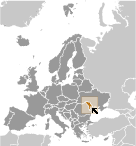World Atlas: Moldova. On this page you can see the map, country flag and many detailed information about the people, history and economy of Moldova.

Here you can find online selected information about the geography, inhabitants, government, economy and history of Moldova. Included are selected statistics, an overview map and the detailed map of Moldova. But let's start with the flag of Moldova here:
Moldova - Overview:
What you should know about Moldova? Let's start with this: A large portion of present day Moldovan territory became a province of the Russian Empire in 1812 and then unified with Romania in 1918 in the aftermath of World War I. This territory was then incorporated into the Soviet Union at the close of World War II. Although Moldova has been independent from the Soviet Union since 1991, Russian forces have remained on Moldovan territory east of the Nistru River supporting the breakaway region of Transnistria, whose population is roughly equally composed of ethnic Ukrainians, Russians, and Moldovans. Years of Communist Party rule in Moldova post-independence ultimately ended with election-related violent protests and a rerun of parliamentary elections in 2009. Since then, a series of pro-European ruling coalitions have governed Moldova. As a result of the country's most recent legislative election in November 2014, the three pro-European parties that entered Parliament won a total of 55 of the body's 101 seats. Infighting among coalition members led to prolonged legislative gridlock and political instability, as well as the collapse of two governments, all ruled by pro-European coalitions centered around the Liberal Democratic Party (PLDM) and the Democratic Party (PDM). A political impasse ended in January 2016 when a new parliamentary majority led by PDM, joined by defectors from the Communists and PLDM, supported PDM member Pavel Filip as prime minister. Moldova remains Europe's poorest economy, but has made steps toward expanding its market access by signing and ratifying an Association Agreement with the EU in 2014, which fully entered into force in July 2016 after ratification by all EU member states. Igor Dodon won Moldova's first direct presidential election in over 20 years in November 2016.
Geography of Moldova
 Where on the globe is Moldova? The location of this country is Eastern Europe, northeast of Romania. Total area of Moldova is 33,851 sq km, of which 32,891 sq km is land. So this is not a large country. How could we describe the terrain of the country? This way: rolling steppe, gradual slope south to Black Sea. The lowest point of Moldova is Dniester (Nistru) 2 m, the highest point Dealul Balanesti 430 m. And the climate is moderate winters, warm summers.
Where on the globe is Moldova? The location of this country is Eastern Europe, northeast of Romania. Total area of Moldova is 33,851 sq km, of which 32,891 sq km is land. So this is not a large country. How could we describe the terrain of the country? This way: rolling steppe, gradual slope south to Black Sea. The lowest point of Moldova is Dniester (Nistru) 2 m, the highest point Dealul Balanesti 430 m. And the climate is moderate winters, warm summers.
Inhabitants of Moldova
Let's take a look how many people live in Moldova. The number is: 3,474,121 (July 2017 est.). So this is not very populous country. Who lives here? Moldovan 75.1%, Romanian 7%, Ukrainian 6.6%, Gagauz 4.6%, Russian 4.1%, Bulgarian 1.9%, other 0.8% (2014 est.). What are the languages in Moldova? Moldovan/Romanian 80.2% (official) (56.7% identify their mother tongue as Moldovan, which is virtually the same as Romanian; 23.5% identify Romanian as their mother tongue), Russian 9.7%, Gagauz 4.2% (a Turkish language), Ukrainian 3.9%, Bulgarian 1.5%, Romani 0.3%, other 0.2% (2014 est.). And the religions: Orthodox 90.1%, other Christian 2.6%, other 0.1%, agnostic . How old are the people in average? 36.7 years. We have to add that this number is the median - so one half of the people is older than this, one half is younger. And what is their life expectancy (at birth)? This: 71 years. Where the people live in Moldova? Here: pockets of agglomeration exist throughout the country, the largest being in the center of the country around the capital of Chisinau, followed by Tiraspol and Balti. The major urban areas of Moldova are: Chisinau (capital) 725,000 (2015).
Government and Economy of Moldova
The capital of Moldova is Chisinau in Romanian (Kishinev in Russian) and the government type parliamentary republic. Let's take a look at the administrative divisions - 32 raions (raioane, singular - raion), 3 municipalities (municipii, singular - municipiul), 1 autonomous territorial unit (unitatea teritoriala autonoma), and 1 territorial unit (unitatea teritoriala). Regarding the economy of Moldova, important industrial products are sugar processing, vegetable oil, food processing, agricultural machinery; foundry equipment, refrigerators and freezers, washing machines; hosiery, shoes, textiles. Important agricultural products are vegetables, fruits, grapes, grain, sugar beets, sunflower seeds, tobacco; beef, milk; wine. The most important export commodities are foodstuffs, textiles, machinery and the most important export partners are Romania 25.5%, Russia 11.6%, Italy 9.9%, Germany 6.3%, UK 5.7%, Belarus 5.2% (2016). The most important import commodities are mineral products and fuel, machinery and equipment, chemicals, textiles and the most important import partners are Romania 13.7%, Russia 13.3%, China 9.8%, Ukraine 9.5%, Germany 7.9%, Italy 7%, Turkey 6.8% (2016). How rich is Moldova and how rich are people in this country? The most important number here is GDP per capita (PPP): $5,700 (2017 est.). This is quite a low number. Let's add that this means Gross Domestic Product per person, which is recalculated with respect to the relative cost of local goods and services. And one more important number - population below poverty line: 20.8% (2013 est.).